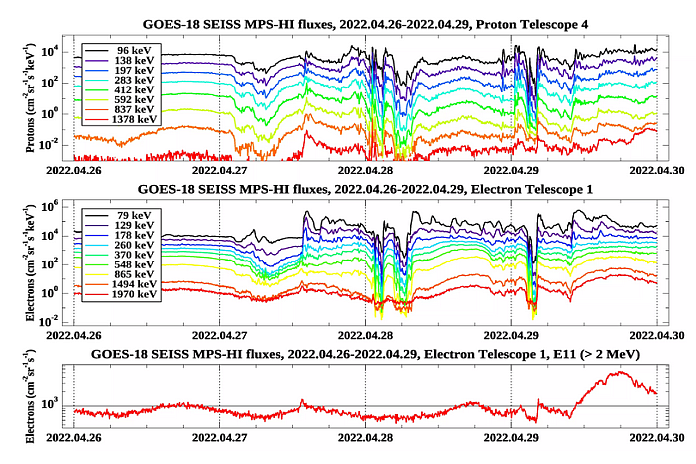WASHINGTON, USA – The Space Environment In-Situ Suite (SEISS) instrument onboard NOAA’s GOES-18 satellite is now sending radiation data back to Earth.
GOES-18 launched on March 1, 2022, and the SEISS sensors have been collecting data continuously since April 25, 2022. SEISS is a suite of sensors that monitor proton, electron, and heavy-ion fluxes in the magnetosphere.
These plots show a number of radiation belt disturbances throughout the three-day time period of April 27-29, 2022.
On April 27, 2022, at mid-day, the GOES-18 SEISS detected the radiation belt effects of a geomagnetic storm. The radiation belts are regions of space around Earth filled with energetic electrons and protons. The GOES-18 SEISS Magnetospheric Particle Sensor – High Energy (MPS-HI) measured a rapid increase in electron flux of the three lowest energy channels (the black, purple, and blue curves on the middle panel), by nearly a factor of 100, during these disturbances.
The proton fluxes increased by a factor of 10 (top panel). Shortly after these observations were seen by the GOES-18 SEISS, NOAA’s Space Weather Prediction Center (SWPC) issued an alert for a G1 (minor) geomagnetic storm. The alert warned of weak power grid fluctuations and minor impacts on satellite operations. It also pointed to the possible presence of aurora at high latitudes in the northern tier of the US, such as northern Michigan and Maine.
One consequence of these disturbances can be seen in the SEISS MPS-HI Channel E11 data (bottom panel) as an increase in the electron flux above 1,000 particle flux units by mid-day on April 29, 2022, when SWPC issued a radiation alert based on the operational GOES East (GOES-16) SEISS data. The alert warned of possible risk to satellite systems due to charging.
After GOES-18 is assigned the operational role as NOAA’s GOES West satellite in early 2023, SWPC will use the SEISS data to issue radiation belt alerts.





